Quality Roofer Dallas: A Comprehensive Guide to The Best Roofing Materials For Harsh Climates

Selecting the appropriate roofing material for harsh climates is crucial to ensure the longevity, sustainability, and overall performance of a building. The roof serves as the first line of defense against extreme weather conditions, such as heavy snow, intense heat, high winds, and torrential rains. Consulting with Quality Roofer Dallas expert, located at 11127 Shady Trail Ste 104, Dallas, TX 75229, United States, can help you choose the right material that not only provides adequate protection against these elements but also contributes to energy efficiency, reduces maintenance costs, and enhances the building’s aesthetics.
When choosing a roofing material for harsh climates, several factors need to be considered to make an informed decision. These factors include:
- Durability: The roofing material should have a long lifespan and be able to withstand the wear and tear caused by extreme weather conditions. It should be resistant to cracking, breaking, or warping due to temperature fluctuations, heavy snow loads, or high winds.
- Weather resistance: The material should provide adequate protection against the specific weather challenges of the region, such as intense UV radiation, hailstorms, or hurricane-force winds. It should also have excellent water-shedding capabilities to prevent leaks, mold, and rot.
- Energy efficiency: The roofing material should contribute to the building’s overall energy efficiency by providing insulation and minimizing heat transfer. In hot climates, it should reflect sunlight and reduce cooling costs, while in cold climates, it should help retain heat and lower heating costs.
- Maintenance requirements: Ideally, the roofing material should require minimal maintenance and be easy to repair in case of damage. The cost of maintenance and repairs should be factored into the overall cost of the roofing system.
- Aesthetics: The roofing material should be visually appealing and complement the building’s architectural style. It should also be available in a variety of colors and textures to suit individual preferences and requirements.
- Cost: The overall cost of the roofing system should be within the budget, considering both the initial installation cost and long-term maintenance expenses. It’s essential to balance cost with durability, weather resistance, and energy efficiency to ensure a wise investment.
Choosing the appropriate roofing material for harsh climates is vital to ensure the building remains protected, energy-efficient, and visually appealing. By considering factors such as durability, weather resistance, energy efficiency, maintenance requirements, aesthetics, and cost, building owners can make an informed decision and select the best roofing material for their specific needs.
Metal Roofing
Metal roofs have become increasingly popular in recent years due to their durability, weather resistance, and energy efficiency, making them an excellent choice for harsh climates. Here, we will explore the benefits of metal roofs in extreme conditions and compare various types of metal materials, discussing their pros and cons.
Benefits of Metal Roofs in Harsh Climates
- Durability: Metal roofs have a long lifespan, typically ranging from 40 to 70 years, depending on the material used. They are resistant to cracking, breaking, and warping due to temperature fluctuations, making them ideal for regions with extreme weather conditions.
- Weather resistance: Metal roofs are highly resistant to various weather challenges, including heavy snow, high winds, and intense sun exposure. They have excellent water-shedding capabilities, preventing leaks and water damage. Additionally, metal roofs are resistant to fire, mold, and pests, further enhancing their durability and performance.
- Energy efficiency: Metal roofs can help reduce energy consumption by reflecting sunlight and reducing heat absorption, especially in hot climates. This can lead to lower cooling costs during summer months. Some metal roofs can also be insulated to improve their energy efficiency in cold climates, reducing heating costs.
- Low maintenance: Metal roofs require minimal maintenance and can withstand harsh weather conditions without significant damage. They are easy to clean and repair if needed.
Types of Metal Materials And Their Pros And Cons
Steel
- Pros: Steel is the most common and affordable metal roofing material. It’s durable, strong, and resistant to corrosion when coated with zinc or aluminum alloy. Steel can also be coated with a paint finish to enhance its appearance and resistance to the elements.
- Cons: Steel is heavier than other metal roofing materials, which may require additional structural support. It can be prone to rust if the protective coating is damaged.
Aluminum
- Pros: Aluminum is lightweight, corrosion-resistant, and highly reflective, making it ideal for hot climates. It is also highly malleable, allowing for various styles and designs.
- Cons: Aluminum is more expensive than steel and may not be as strong, making it less suitable for regions with high winds or heavy snow loads.
Copper
- Pros: Copper is an attractive and long-lasting roofing material, with a lifespan of up to 100 years. It is highly resistant to corrosion and develops a beautiful patina over time, enhancing its appearance.
- Cons: Copper is expensive and may be prone to theft due to its high value. It can also be challenging to install and requires skilled professionals.
Zinc
- Pros: Zinc is highly durable, corrosion-resistant, and has self-healing properties, which means minor scratches or imperfections will repair themselves over time. It is also lightweight and has a low environmental impact.
- Cons: Zinc is more expensive than steel or aluminum and may require specialized installation techniques.
Metal roofs are an excellent choice for harsh climates due to their durability, weather resistance, and energy efficiency. While steel and aluminum are the most common options, copper and zinc offer unique benefits and aesthetic appeal. It’s essential to weigh the pros and cons of each material and consider factors such as cost, strength, and appearance when choosing the best metal roofing material for your needs. By consulting with Quality Roofer Dallas, located at 11127 Shady Trail Ste 104, Dallas, TX 75229, United States, or calling them at 2148337020, you can get professional guidance in selecting the right metal roofing material for your specific requirements.
Asphalt Shingles
Asphalt shingles are a popular roofing material due to their affordability, ease of installation, and variety of styles and colors. However, it’s essential to consider their advantages and disadvantages in harsh climates and choose the most suitable asphalt shingle for your specific needs.
Advantages of Asphalt Shingles in Harsh Climates
- Affordability: Asphalt shingles are less expensive than other roofing materials like metal, slate, or tiles, making them an attractive option for budget-conscious homeowners.
- Ease of installation and repair: Asphalt shingles can be installed quickly, and any damaged shingles can be easily replaced without requiring specialized tools or skills.
- Variety: Asphalt shingles come in a wide range of colors, textures, and styles, allowing homeowners to customize the appearance of their roofs to match their preferences and the architectural style of their homes.
Disadvantages of Asphalt Shingles in Harsh Climates
- Limited lifespan: Asphalt shingles have a shorter lifespan compared to other roofing materials, typically lasting between 20 to 30 years. In harsh climates, their lifespan may be even shorter due to increased wear and tear from extreme weather conditions.
- Vulnerability to extreme weather: Asphalt shingles can be susceptible to damage from high winds, heavy snow loads, and hail. In hot climates, they may experience thermal cracking due to temperature fluctuations or warp and buckle due to heat.
- Lower energy efficiency: Asphalt shingles have a lower energy efficiency compared to metal or tile roofing materials. They absorb heat in hot climates, which can lead to increased cooling costs.
Selecting The Most Suitable Asphalt Shingle For a Particular Climate
- Climate-specific shingles: Some asphalt shingle manufacturers offer climate-specific products designed to withstand the challenges of specific regions, such as high winds, heavy snow, or intense heat. Look for shingles that are specifically designed for your climate to ensure maximum performance and durability.
- Wind resistance: In areas prone to high winds or hurricanes, choose asphalt shingles with a higher wind resistance rating. These shingles are designed with additional adhesive strips and reinforced nailing patterns to better withstand strong winds.
- Impact resistance: If you live in an area prone to hailstorms, consider impact-resistant asphalt shingles. These shingles have a higher resistance to impacts from hail or debris, reducing the risk of damage and prolonging their lifespan.
- Reflectivity: For hot climates, opt for asphalt shingles with a higher solar reflectance index (SRI) to minimize heat absorption and reduce cooling costs. Light-colored shingles tend to have a higher reflectivity, but some manufacturers offer specially designed cool roof shingles in various colors.
While asphalt shingles have certain advantages like affordability and ease of installation, they may not be the most durable or energy-efficient choice in harsh climates. To select the most suitable asphalt shingle for your specific climate, consider factors such as wind resistance, impact resistance, and reflectivity, and look for climate-specific products designed to withstand the challenges of your region. By reaching out to Quality Roofer Dallas, located at 11127 Shady Trail Ste 104, Dallas, TX 75229, United States, or visiting their website at https://qualityroofer.com/service-areas/dallas-tx/, you can benefit from their expertise in selecting the best asphalt shingle tailored to your needs and the local climate.
Slate And Tile Roofing
Slate and tile roofing materials are known for their durability, longevity, and aesthetic appeal, making them a popular choice for homeowners in harsh climates. This section examines the advantages of slate and tile roofing in extreme conditions and discusses the factors to consider when choosing between these two materials.
Durability And Advantages of Slate And Tile Roofing in Harsh Climates
- Longevity: Both slate and tile roofs have impressive lifespans, with slate roofs lasting up to 100 years or more and tile roofs lasting 50 to 100 years. This makes them an excellent choice for homeowners seeking a long-lasting roofing solution.
- Weather resistance: Slate and tile roofs are highly resistant to harsh weather conditions, such as heavy snow, high winds, and hail. Their natural weight and interlocking design make them less prone to damage from wind uplift. In addition, their water-shedding capabilities help prevent leaks and water damage.
- Fire resistance: Both slate and tile roofing materials are non-combustible, providing excellent protection against fire hazards.
- Energy efficiency: Slate and tile roofs have good insulating properties, making them energy efficient. In hot climates, their thermal mass helps reduce heat transfer, keeping the interior cooler and reducing cooling costs. In cold climates, they help retain heat, lowering heating costs.
- Aesthetics: Slate and tile roofs offer a distinctive and timeless appearance, adding character and curb appeal to a home. Both materials are available in various colors, shapes, and textures, allowing homeowners to customize the look of their roofs.
Factors to Consider When Choosing Between Slate or Tile Roofing Materials
- Cost: Slate is generally more expensive than tile, both in terms of material and installation costs. Homeowners should consider their budget when deciding between these two materials.
- Weight: Slate and tile roofing materials are significantly heavier than other options like asphalt or metal. The home’s structure must be able to support the additional weight, and in some cases, reinforcement may be necessary.
- Climate: While both materials are suitable for harsh climates, slate may be a better choice in areas with more extreme temperature fluctuations due to its higher resistance to cracking. On the other hand, tile roofing may be more suitable for hot and sunny climates where its thermal mass can help reduce heat transfer.
- Maintenance: Slate roofs generally require less maintenance than tile roofs, as they are less prone to cracking and breaking. However, both materials may require occasional inspection and repair to ensure their longevity.
- Installation expertise: The installation of slate and tile roofs requires specialized skills and expertise. It’s essential to work with an experienced roofing contractor familiar with these materials to ensure proper installation and prevent potential issues.
Both slate and tile roofing materials offer excellent durability, weather resistance, and aesthetic appeal in harsh climates. When choosing between the two, homeowners should consider factors such as cost, weight, climate, maintenance, and installation expertise to make an informed decision that best meets their needs and preferences.
Conclusion
The best roofing materials for harsh climates include metal roofing, asphalt shingles, and slate or tile roofing. Each material offers specific benefits and drawbacks, making it essential to weigh the pros and cons based on factors such as durability, weather resistance, energy efficiency, maintenance, aesthetics, and cost.
Metal roofing is known for its durability, weather resistance, and energy efficiency, making it an excellent choice for extreme conditions. Asphalt shingles are affordable and versatile, but they may not be the most durable or energy-efficient option in harsh climates, so selecting the right type of shingle is crucial. Slate and tile roofing materials offer impressive longevity, weather resistance, and aesthetic appeal, but they can be more expensive and require specialized installation expertise.
When making a decision about roofing materials, it’s essential to consult with a professional roofing contractor who can assess your specific needs, climate, and budget, and recommend the most suitable material for your home. By working with a professional, you can ensure proper installation, maximize the performance and lifespan of your roof, and make a wise investment in your home’s protection and energy efficiency.



